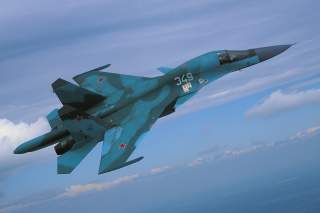Does Russia Really Want to Replace the Su-25 Frogfoot with the Su-34 Fullback bomber?
A single-seat fast-moving strike fighter aircraft is not optimal for the close air support role.
A senior Russian official is suggesting that Moscow should develop a single-seat derivative of the Sukhoi Su-34 Fullback bomber to replace the Sukhoi Su-25 Frogfoot close air support aircraft. However, it is unclear what benefit the Russian Air Force would derive from building such a machine.
"My opinion is that a new attack aircraft should be made on the basis of the Su-34 after all,” former Russian Aerospace Force commander and current chairman of Russia’s Federation Council Defense and Security Committee Viktor Bondarev told the TASS news agency. “This is a splendid plane. It is maneuverable and has eight tonnes of the bomb load against four tonnes carried by the Su-25. It has excellent characteristics… I believe that it is simpler and easier to make a cockpit for one pilot and leave all the rest as it is.”
Bondarev is likely correct that a single-seat derivative of the Su-34 would be technically feasible easy enough to build. Indeed, the Fullback itself is an intermediate-range bomber derivative of the long-serving Sukhoi Su-27 Flanker air superiority fighter, which was originally developed as a single-seat airframe.
However, while it made sense to convert the Su-27 airframe into a longer-range interdiction aircraft with a weapons systems officer onboard to share the workload, developing a new single-seat derivative of the supersonic bomber aircraft for the close air support role does not seem to make sense. The Flanker airframe is at its best at medium to high altitudes rather than at low levels where it is vulnerable to ground fire. Moreover, a single-seat fast-moving strike fighter aircraft is not optimal for the close air support role.
Nonetheless, the Russians will need to replace the Su-25 at some point—that is true. ”An attack aircraft will always be needed,” Bondarev said. “The Su-25 has been upgraded to the Su-25SM3 version. It has a very reliable airframe and huge modernization and repair potential. I believe it will fly for another 10-15 years. Naturally, we will have to replace it eventually and today various options are being considered.”
However, while the Flanker-series jets are fantastic and versatile warplane designs, the airframes are not ideal for the close air support role and probably should not be used to replace the Su-25. A source in the defense industry told apparently told TASS that the Russians are working on an experimental design for an attack aircraft based on the Su-34 bomber, which could start development in 2018. The project, as with many Russian Air Force lines of effort, seems to be completely redundant and would remove one of the Fullback’s key advantages—the presence of a dedicated weapons systems officer.
However, a supersonic attack aircraft design would make somewhat more sense than a replacement for the Su-25, though newer Flanker derivatives such as the Su-30SM and Su-35S have significant built-in strike capability already. But a Su-25 replacement should logically look more like a next-generation version of the Frogfoot or the U.S. Air Force’s A-10 Warthog, both of which are designed to fly at low altitudes and absorb serious punishment from ground fires. Certainly, a Flanker derivative is not suitable for that role.
It is possible that Bondarev, who is no longer a serving Russian military officer, was simply expressing his personal opinion. Russian sources indicated that power inside the country rests purely with the executive branch and comments from the legislative branch should not be taken seriously.
Dave Majumdar is the defense editor for The National Interest. You can follow him on Twitter: @davemajumdar.
Image: United Aircraft Corporation

